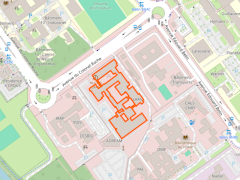Silicon-based Actuators and Sensors
These MEMS devices are capable of generating and detecting movements and vibrations on incredibly small scales ranging from a few micrometers to less than a picometer. Their applications are diverse: from energy-frugal manipulation of logical data to enhancing the measurement performance of force sensors used in atomic force microscopy.
Optomechanical probes for atomic force microscopy
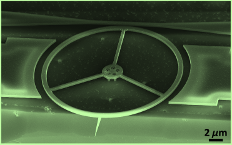
The strong coupling achieved in silicon optomechanical microcavities enables the actuation of micro/nanosystems by optical forces as well as the measurement of their displacements with sub-femtometer resolution at frequencies exceeding GHz. This paves the way for vibrating micro-sensors with exceptional performance that we are developing for atomic force microscopy (AFM). The objective is to open a new experimental window for AFM with optomechanical probes operating at a frequency a thousand times higher than the usual cantilever probe and with non-perturbative vibration amplitudes. The first applications concern highly time-resolved force spectroscopy, on the scale of tens of nanoseconds, to study dynamic processes in biological molecular complexes. Another perspective within the framework of ongoing collaborations concerns the use of these optomechanical probes for quantum AFM. Their resonance frequency above GHz, combined with operation at a temperature below 10 mK, will place the mechanical resonator of the AFM probe in its quantum ground state, allowing the measurement of energy exchanges at the single phonon level.
Researcher
Bernard Legrand
Engineers
Nicolas Mauran, Laurent Mazenq, Samuel Charlot
Project
ANR AAPG HERMES 2022-2026 in collaboration with MPQ Paris, CEA-LETI Grenoble, DyNaMo Marseille
ANR Capteurs Quantiques SINPHONY 2024-2028 in collaboration with MPQ Paris, CEA-LETI Grenoble
Publications
- Optomechanical resonating probe for very high frequency sensing of atomic forces,
P.E. Allain, L. Schwab, C. Mismer, M. Gély, E. Mairiaux, M. Hermouet, B. Walter, G. Leo, S. Hentz, M. Faucher, G. Jourdan, B. Legrand, and I. Favero, Nanoscale, 12 (2020) 2939-2945. Selected for the themed collection: 2020 Nanoscale HOT Article Collection - Low Latency Demodulation for High-Frequency Atomic Force Microscopy Probes,
D. Lagrange, N. Mauran, L. Schwab, and B. Legrand, IEEE Transactions on Control Systems Technology, 29, 5 (2020) 2264-2270 - Very high frequency probes for atomic force microscopy with silicon optomechanics,
L. Schwab, P. E. Allain, N. Mauran, X. Dollat, L. Mazenq, D. Lagrange, M. Gély, S. Hentz, G. Jourdan, I. Favero, and B. Legrand, Nature Microsystems and Nanoengineering, 8 (2022) 32
arXiv: https://arxiv.org/abs/2109.02478
HAL: https://hal.archives-ouvertes.fr/hal-03326075 - Behavior analysis of comb-drive actuators operating in near-zero-overlap configuration,
A. Marković, H. Fanet, G. Pillonnet, and B. Legrand, Sensors and Actuators A: Physical, 376 (2024) 115652 - Suspended tip overhanging from chip edge for atomic force microscopy with an optomechanical resonator, A. Marković, M. Lefebvre, M. Mazenq, S. Charlot, M. Gély, A. Lecestre, M. Arribat, G. Jourdan, and B. Legrand, Journal of Optical Microsystems, 4, 3 (2024) 033501
Ultra-low power logic with capacitive MEMS
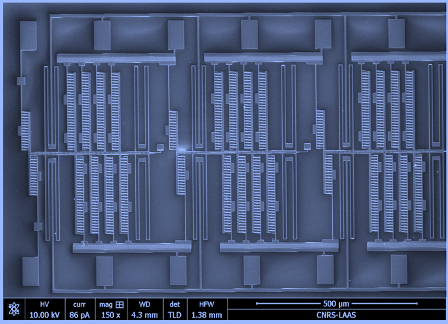
This project explores the development of innovative capacitive MEMS technology with the aim of creating ultra-low-power, contactless logic gates and circuits. Our approach seeks to address certain limitations of electronic transistors, particularly in the realm of static and dynamic power losses. The foundation of the research is the inverter logic gate, which has been successfully implemented on silicon using comb-drive actuators and an architecture designed for adiabatic operation.
Building on this concept, we are investigating more complex logic gates (such as NAND and NOR), with the goal of eventually cascading them to form complete circuits. One of the promising aspects of this technology is its potential for integration with existing MEMS sensors (e.g., accelerometers) on the same physical layer. If successful, this integration could potentially enable in-sensor computing with reduced power consumption.
Initial results suggest that these devices may have the capacity to operate in challenging environments, potentially offering resilience to high temperatures and radiation exposure.
Researcher
Bernard Legrand
Engineers
Adrian Laborde, Laurent Mazenq, Nicolas Mauran,
Project
ANR AAPG ZEROUATE 2020-2025 in collaboration with CEA-LETI Grenoble, ESYCOM Paris, G2ELAB Grenoble
Publications
- Adiabatic Logic Gates for Ultra-Low-Power Operation Using Contactless Capacitive MEMS, A. Marković, L. Mazenq, A. Laborde, H. Fanet, G. Pillonnet, and B. Legrand, 22nd International Conference on Solid-State Sensors, Actuators and Microsystems, Transducers 2023, Kyoto, Japan, june 2023, 546-549
- Behavior analysis of comb-drive actuators operating in near-zero-overlap configuration,
A. Marković, H. Fanet, G. Pillonnet, and B. Legrand, Sensors and Actuators A: Physical, 376 (2024) 115652
Innovative MEMS technologies for reliable gas measurement in harsh environments
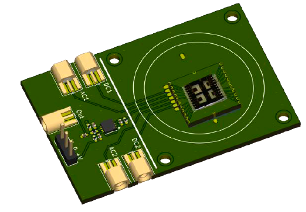
The main aim of the MIGNON project is to develop innovative methods for measuring gases, and to achieve accurate, reliable chemical detection in hostile environments using physical measurements rather than sensitive layers. Within this framework, LAAS plays a key role in coordinating the development of devices, in particular electrostatic MEMS such as silicon microlevers manufactured at LAAS and silicon carbide microlevers as well as capacitive micromechanical ultrasonic transducers (CMUTs) manufactured at GREMAN Tours. These devices are designed to measure gas properties such as mass density, viscosity, sound velocity and attenuation. LAAS is also focusing on the integration of several MEMS into a compact, portable system, guaranteeing accuracy and reliability for gas detection in a variety of applications.
Researchers
Thierry Leïchlé, Liviu Nicu, Daisuke Saya
Engineer
Fabrice Mathieu
Project
ANR AAPG MIGNON 2023-2027 in collaboration with IMS Bordeaux, CRHEA Nice and GREMAN Tours.
Advanced MEMS Sensing: Wireless Interrogation and Non-Linear Regimes
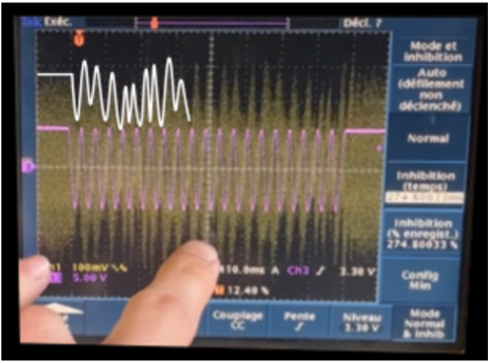
This project focuses on the use of MEMS sensors in harsh environments, characterized by high temperatures, high pressures, radiation, or corrosive and explosive conditions. Our research specifically addresses the challenges related to sensor signal acquisition and processing, with a targeted application for detection in potentially explosive environments. We are exploring two main research axes. The first concerns wireless and remote interrogation of sensors using radio frequency technology. This approach offers the advantage of being applicable to passive sensors, which require neither on-board power sources nor proximity electronics – elements particularly vulnerable in harsh environments. The second axis, more exploratory in nature, investigates advanced operational modes in resonant regimes to compensate for the degradation of the signal-to-noise ratio inherent in harsh environment operations and remote interrogation. We are particularly interested in exploiting non-linearities and chaotic regimes. These approaches show promise in producing enhanced, or even exponential, sensor responses to variations in the measured quantity, thus overcoming the limitations of detection in linear regimes.
Researcher
Bernard Legrand
Engineers
Fabrice Mathieu, Laurent Mazenq
Project
PEPR Electronique, France 2030, projet ciblé RESISTE.
Collaborations : CEA-LETI Grenoble, TIMA Grenoble, IMS Bordeaux
Miniaturized permanent magnets for electromagnetic MEMS
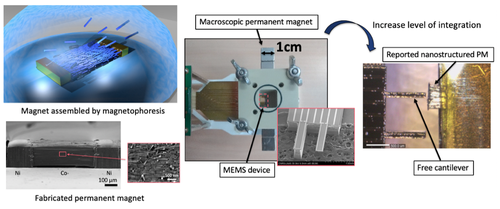
There are two methods of integrating magnets into miniaturized devices: thin-film fabrication and structuring of magnetic polymer composites. Neither of these techniques meets the key application criteria of integrability, performance and thickness. In collaboration with Lise-Marie Lacroix's team at LPCNO, we have developed an alternative method for producing magnets based on the assembly of cobalt nano-rods by evaporation under a magnetic field. This process enables us to produce magnets with magnetic properties intermediate between ferrites and rare-earth magnets. We use these micro-magnets for electromagnetic actuation of gravimetric sensors and vibratory energy recovery. We are also adapting this technique to the production of soft magnets to enhance the performance of inductors in radio-frequency circuits.
Researchers
Liviu Nicu, Thierry Leïchlé
Engineer
Fabrice Mathieu
Project
ANR AAPG POMADE (2019-2024) in collaboration with LPCNO at Toulouse and Institut NEEL at Grenoble ; Pre-maturation Project Région Occitanie SoftRF (2022-2024) with LPCNO; Maturation Project Toulouse Tech Transfer SoftMagneto (2023-2024) with at LPCNO.







